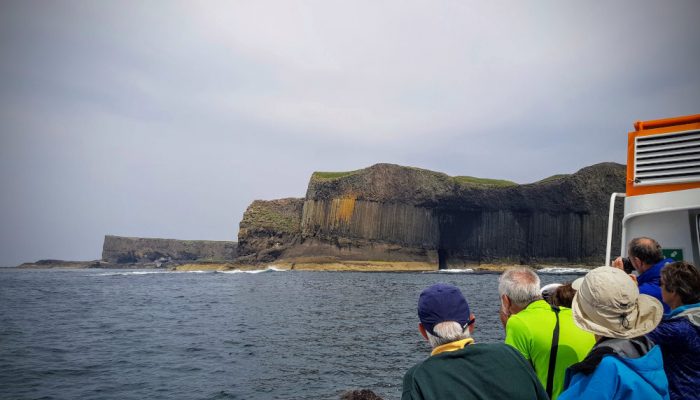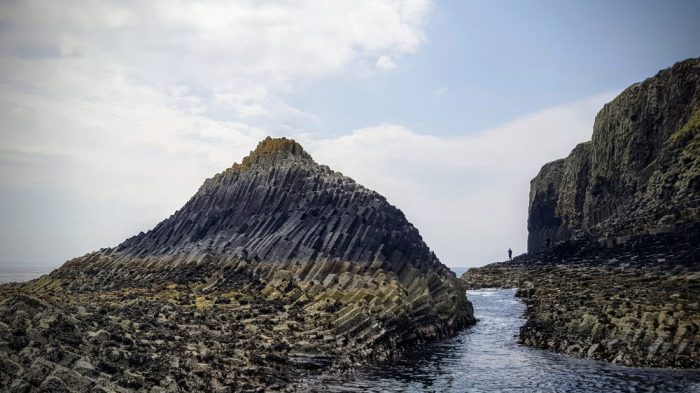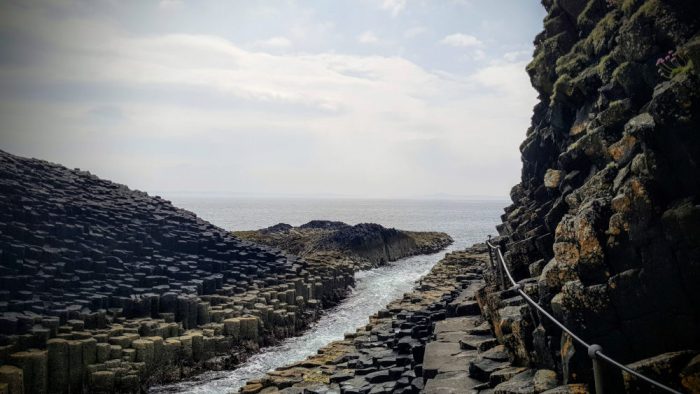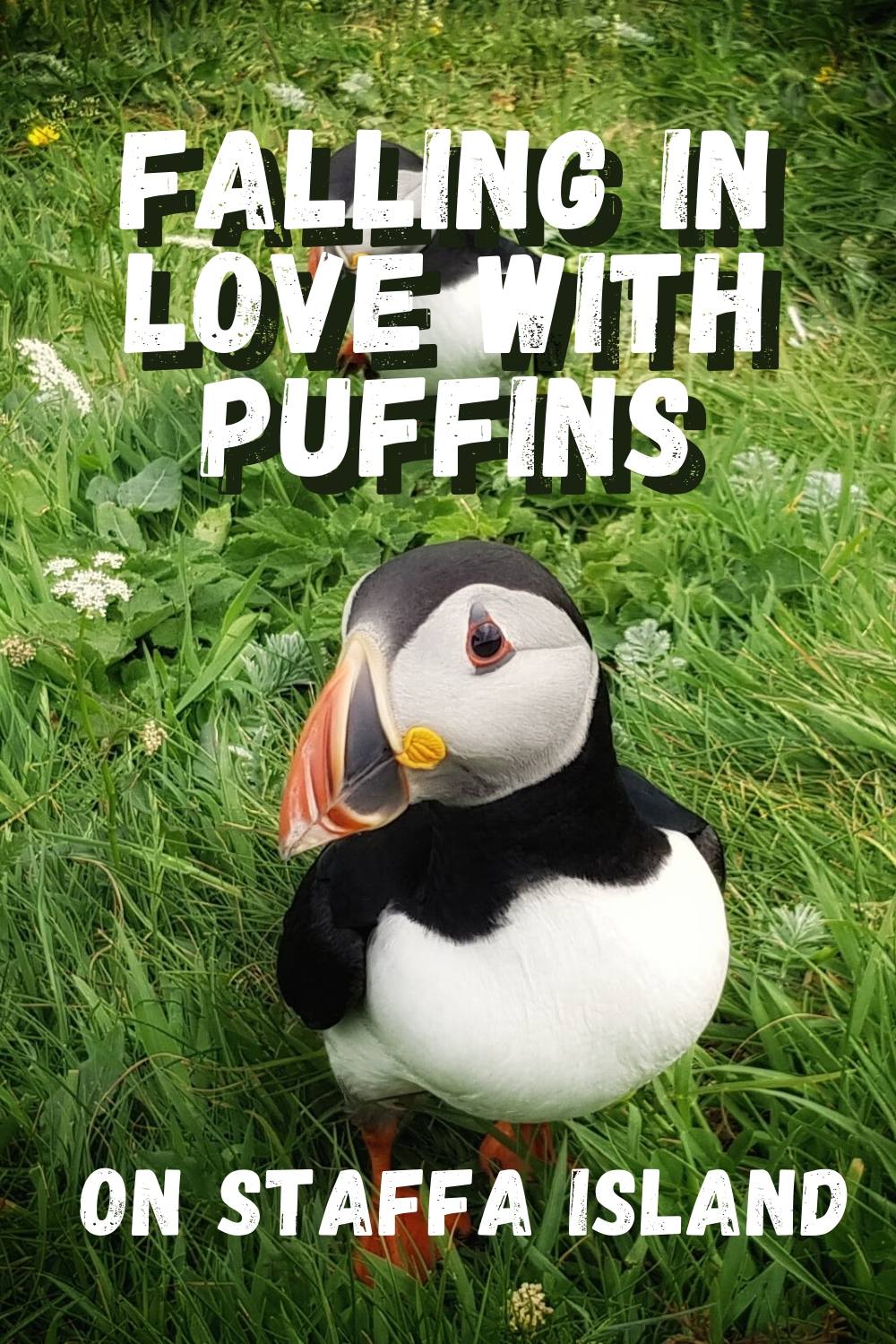Fingal’s Cave – Falling in love with Puffins on Staffa Island
9th Jul 2020I was sat in one of the outside seats on a small boat heading towards Fingal’s Cave on Staffa Island, sea air flowing over my bald head, eyes fixed firmly overboard, scanning the speeding sea. The waterways of the Inner Hebrides are inhabited by whales and dolphins, and if they were here, I was determined to see them.
But no matter how hard I looked, they weren’t showing themselves, not today. The surface of the glassy-calm waters on this delicate Scottish day remained unbroken as Staffa Island grew larger on the horizon, like a pimple on an otherwise unblemished face. I would find plenty of wildlife there.
As Scotland is hardly known for its fair weather, I felt in some way cheated that my experience of this area was atypical. It was bright and sunny without a single breath of breeze, not warm exactly, but certainly bearable in shorts and a T-shirt. I didn’t wallow in my disappointment for long and allowed myself to soak up the rare Scottish sun.
As boats from Staffa passed on their way back to Iona we instinctively waved to our fellow humans travelling in the opposite direction. What is it about travelling by boat that makes us so social and when did it start? We don’t wave to people going the other direction on the motorway. We don’t wave to people on the other side of the street. Maybe we should?
STAFFA ISLAND
Staffa is one of the smallest and most dramatic islands in the area and it has no permanent residents, well not human residents anyway, but more on that later. The name ’Staffa’ is thought to derive from an Old Norse word meaning ‘stave’ like the type used in wooden buildings which is a reminder of regions Viking history.
As gifts go, an island for a birthday present is a monstrous gesture, but that’s exactly what took place when private owner John Elliot gifted Staffa to the National Trust for Scotland in honour of his wife Eleanor’s 60th birthday. As we zipped closer to the big lump of rock, I tried to imagine a large bow attached to its highest point but abandoned that as the spectacular landscape of hexagonal stepping stones and tall pillars came into focus. At its right edge, sucking in gallons of sea water, was the gaping monsters-mouth-like Fingal’s Cave.
Our skipper slipped the boat into neutral and we floated calmly towards the huge cavern on the southern end of the island. It takes discipline, but in situations like this, I try to see the sight through other people’s eyes too. The joy of witnessing something this naturally beautiful is exquisite, but equally joyful is watching others reaction to it. After an initial glance, I turned my attention to my fellow passengers who were peering in silence with awe-filled eyes at the geo-thermic creations of Staffa Island. Magic.

Having soaked up enough reactions, I directed my attention to the uncommon rock formations in front of me. Stepping out from the sea, the basalt columns were too plentiful to count. Along with the columns around the cave itself they also ran some way along the eastern side of the island. The cave seemed strangely inviting from the water and I wished our little boat would get swallowed whole. Alas, it’s not allowed or safe to do so.
We puttered around the eastern side of the island to the concrete pier, pausing to ogle the rocks which flowed in gently curving swoops. Formed from a lava flow 60 million years ago these particular columns are curved because the lava cooled at different rates.

Although out at sea the water was flat calm, close to the island the swell made disembarking a less than simple task. But, having arrived safely on solid rock, we were given two options: a) Take a left and head to Fingal’s Cave or b) Take a right and walk along the cliff tops to see the puffin colony. There was time to do both, but Fingal’s Cave was my priority so I headed left.
With hexagonal stepping stones down to the sea on the left, the path tantalisingly headed right around some tall columns. The swell surged through a channel in the rocks close to the shore, sending huge billows of salty spray up and over anyone that dared to creep too close. With a rope handrail for safety I craned my neck around the corner for my first glimpse of Fingal’s Cave from dry (well, sea soaked rock) land.

As a large spread of columns extended directly away from me into the sea I knew the cave would be approaching on the right. Turning the corner I looked directly into its cavernous mouth. It is no longer possible to continue on the path further into the cave due to recent rock collapses. It mattered not, the cave seemed to have a life of its own as the water surged in and out of the opening. I squinted my eyes to see in as far as possible but no matter how much I tried I couldn’t see the back wall, just darkness.
The cave doesn’t just look beautiful, it sounds beautiful too. Due to its unique dimensions, it has natural reverberation of around 4 seconds which is somewhere between that of a concert hall (2 seconds) and a cathedral (10 seconds). Felix Mendelssohn’s visit here in 1829 inspired his Hebrides Overture (Fingal’s Cave).
Fingal’s Cave
Fingal’s Cave, or by its traditional name – Uamh Binn (Musical Cave) has had more than one famous visitor; it brags visits by Queen Victoria, Jules Verne, Walter Scott, Joseph Turner, Robert Louis Stevenson, Lord Tennyson and Joseph Banks who, following a visit in 1772 wrote: “Compared to this what are the cathedrals and palaces built by men! Mere models or playthings, imitations as his works will always be when compared to those of nature”. Quite.
People have lived next door on Mull for around 8,000 years and it is probable that Staffa’s columns and Fingal’s Cave have always been seen as special and possibly mythical. One legend has it that Gaelic giant Fingal was quarrelling with his Ulster equivalent Finn McCool and a causeway was built to allow them to fight. The columns visible today are said to be the ends of this Giants Causeway. Utter rubbish, obviously…
TUNNOCKS TOP TIP
A word of caution; the stones can get incredibly slippy. Even taking great care and wearing shoes with plenty of grip, I nearly lost my footing on several occasions.
With the boat due to leave in under an hour, I hurriedly scampered back along the slippy stones, past the jetty and out across the soft, mossy fields that top Staffa’s solid rock base. As I neared the colony, I noticed people sat near the cliffs edge with groups of puffins for company.
Not wanting to disturb anybody else’s experience, I found a spot of my own and within two minutes I’d made my first feathered friend. With his stout body and short wings, the landing he deployed was less than graceful as he appeared in a heap at my feet.
Gathering himself and standing upright, it was immediately apparent why these are some of the most loved birds on our planet. Cute beyond belief he strode around with all the ability of an over-confident toddler, tripping over a lot and squawking at anything that moved. He was using me as protection from the local gull population and I couldn’t have been happier.

These adorable little creatures mate for life, can dive up to 60ft to catch sand eels and somehow fly all the way to the mid-atlantic for winter. As time passed several more puffins came and joined the party and like little people, they all seemed to have their own distinct personality. However, they all shared the complete inability to stick a landing with any grace what-so-ever.
Before long I realised that I was the only person still sat on the cliff-side. It was time to return to the boat and leave Staffa Island, Fingal’s Cave and my gang of tiny feathered friends.
What else is around?
Most tours to Staffa include a stop at the tranquil Iona island. And there are many other local delights with tours departing from Oban like this one that includes Mull as well as the West Highlands.
Here’s what The Ultimate Travelist said:
“It sounds like something from The Hobbit and has inspired Pink Floyd and Mendelssohn. Even the boat trip to Fingal’s Cave is an adventure; you may see eagles and whales before the island of Staffa comes into view. The cave, reached by a path cut into the rock, is cathedral-like, its interior marked with hexagonal basalt pillars. Perhaps they were created by volcanic activity, perhaps by the same hero who built Giant’s Causeway. Either way, it’s a magical trip.”
Get your copy of Lonely Planet’s Ultimate Travelist here.
Ultimate Travelist Challenge Sum up
Fingal’s Cave appears in the Ultimate Travelist Challenge at number 490. It’s hard to say whether this trip was more enjoyable for Fingal’s Cave itself or the puffin experience. They were both extraordinary in very different ways and I think I either one on its own would have left me very happy.
Have you been to Fingal’s Cave? Did you make feathered friends? Do you think it is rightly in the Ultimate Travelists Top 500? Would love to hear your thoughts in the comments below.
Posts like this:
DISCOVER THE MANY FASCINATING SIDES OF PORTMEIRION VILLAGE
CAERNARFON CASTLE – DID YOU KNOW WE ALMOST HAD A KING ALPHONSO?

Sponsored links
This post contains some links that go to external companies. If you decide to click on one of these links and make any purchase then I am lucky enough to get a tiny kickback. It won't cost you any more and it'll help keep this website afloat. I'll only ever link to awesome stuff. Promise.


1 Comment